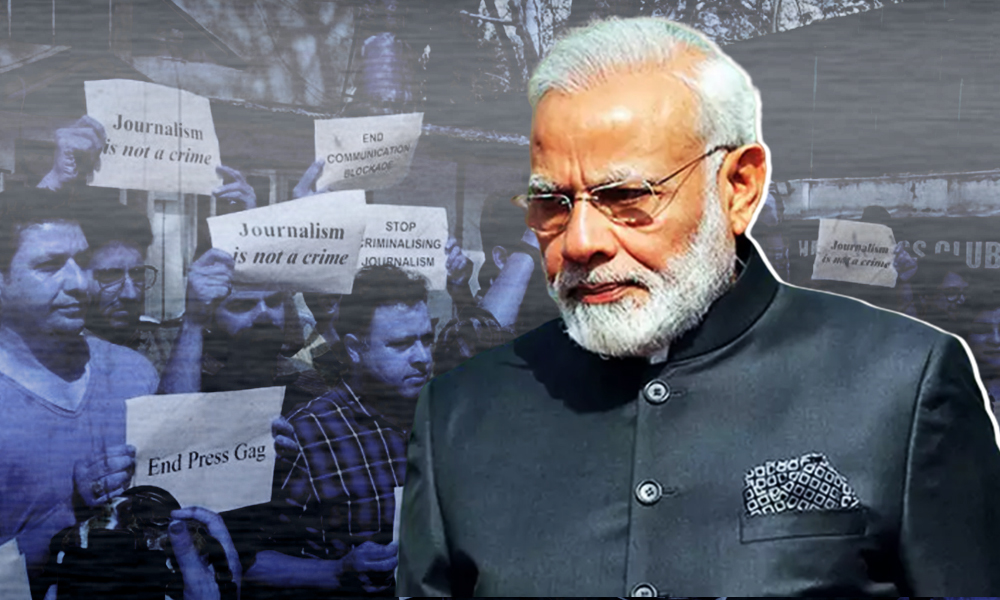
Image Credits: India Today
World Press Freedom Ranking: Has Indian News Media Lost Credibility?
29 April 2020 1:08 PM GMT | Updated 29 April 2020 1:33 PM GMT
Editor : Shubhendu Deshmukh |
Shubhendu, the quint essential news junky, the man who loves science and politics in equal measure and offers the complete contrast to it by being a fan of urdu poetry as well.
Creatives : Abhishek M
" An engineer by profession, Abhishek is the creative producer of the team, graphic designing is his passion and travelling his get away. In more ways than one, he makes the content visually appealing."
In the age of post-truth and fake news, where a few journalists are forced either to toe the government's line or face consequences, the majority of news media seems to be voluntarily suppressing their voices.
The Reporters Without Borders' annual press freedom index, which was released on April 21, has ranked India at 142 among 180 countries.
Titled 2020 World Press Freedom Index, the report says that the Indian media reeling under a Hindu nationalist government, which has time and again tried to gag journalists.
Paris-based Reporters Sans Frontieres (RSF), or Reporters Without Borders, is a non-profit organisation that works to document and combat attacks on journalists around the world. In its report, RSF attributes India's ranking to the Narendra Modi government "tightening" its grip on the media, and pressuring it to "toe the Hindu nationalist government's line".
"With no murders of journalists in India in 2019, as against six in 2018, the security situation for the country's media might seem, on the face of it, to have improved. However, there have been constant press freedom violations, including police violence against journalists, ambushes by political activists, and reprisals instigated by criminal groups or corrupt local officials," it said.
"Ever since the general elections in the spring of 2019, won overwhelmingly by Prime Minister Narendra Modi's Bharatiya Janata Party, pressure on the media to toe the Hindu nationalist government's line has increased," it added.
Media Adding Communal Colour
In the recent past, there have been numerous incidents that were blatantly communalised by the media.
Last month, around 9,000 people had participated in the Tablighi Jamaat conference in Delhi's Nizamuddin. After the event, many of the attendees travelled to various parts of the country. Reportedly, a third of the nearly 3,000 coronavirus cases reported during that time were either people who attended the Tablighi gathering or those who came in contact with them.
The incident proved to be fodder for several media houses to communalise a global pandemic. A barrage of fake news targeting the Muslim community for the pandemic also followed suit, both by social media users and mainstream media. With the use of hashtags like #CoronaJihad and #BioJihad the pandemic took the form of a hate campaign against the minority community.
People's fear of coronavirus and existing religious tensions further fuelled Islamophobia in the country.
Another incident where the mainstream media used the pandemic to spread hatred regarding the minority community was when a huge crowd of migrant workers gathered at the Bandra railway station in Mumbai on April 14, following PM Narendra Modi's announcement of the extension of the lockdown.
While there were similar gatherings in Surat, Gujarat, channels focused solely on the Bandra incident. Moreover, channels like NewsNation, India TV, and ABP were fixated on why the crowd gathered near a masjid at the station - even when the masjid played no role in the gathering. The migrants, hungry and needy, just wanted to go to their hometowns, and yet, the media was desperate to find a non-existent religious angle.
The RSF report also pointed out "a clear correlation between suppression of media freedom in response to the coronavirus pandemic and a country's ranking in the Index."
Fake News, A Handy Weapon
"State troll armies in Russia, India, Philippines and Vietnam use the weapon of disinformation on social media," it added. In the case of the Jamaat incident, there were a number of fake videos that surfaced online which claimed that Muslims were deliberately spreading coronavirus.
Almost all political party IT cells have paid worker continuously distributing fake news. What's surprising about Indian media is the mainstream media is deliberately propagating fake news along with the IT cells. Several fake reports of the mainstream media were also called out by the police.
For instance, a report by Zee News's Uttar Pradesh and Uttarakhand segment published on April 6, claimed that a medical team escorting coronavirus-positive members of the Tablighi Jamaat was pelted with stones in Uttar Pradesh.
However, Firozabad police debunked the claim saying, "You are spreading false and misleading news when neither a medical team nor any ambulance has been pelted with stones in Firozabad district."
Similarly, in the Palghar case, where two sadhus and their driver were lynched, the media houses that are the motormouths of the Hindu nationalist agenda were quick to give it a communal angle.
The three men were coming from Mumbai in a van when the local residents stopped them on the Dhabadi-Khanvel road near Gadchinchle village and attacked them on the suspicion that they were child kidnappers and organ harvesters.
While the attack had no religious angle to it, fake messages swarmed social media, with some even claiming that Muslims were behind it., while both the victims and attackers were Hindus. Hashtags like #JusticeForHinduSadhus were also trending. Some BJP leaders also politicised the brutal incident.
इस वीडियो के लास्ट में बहुत ध्यान से सुनें, साफ़ साफ़ एक लड़का बोल रहा है, " मार शोएब मार "
— Mohit Bharatiya 🇮🇳 #StayHome #StaySafe ! (@mohitbharatiya_) April 19, 2020
Listen carefully man inciting another Shoaib fr lynching Hindu saint "maar maar Shoaib maar"#Palghar_Incident pic.twitter.com/aQO8fp3UdY
As the claims of communal violence rose, Maharashtra Chief Minister Uddhav Thackeray refuted them. "Those trying to inflame passions, must desist from doing so. There is no Hindu-Muslim angle or communalism in this attack," he tweeted on April 20. However, the narratives continued in a section of the media.
Those trying to inflame passions, must desist from doing so. There is no Hindu-Muslim angle or communalism in this attack. Two policemen were suspended immediately. The CID Crime will inquire into this incident and DGP Atul Kulkarni will lead the probe
— CMO Maharashtra (@CMOMaharashtra) April 20, 2020
Furthermore, Maharashtra Home Minister Anil Deshmukh on Wednesday, April 22, shared the list of 101 accused who have been arrested in connection with the incident and categorically mentioned that none of the arrested were Muslims. He also appealed to people to not add any religious colour to the incident or communalise it in any way.
The list of the 101 arrested in the #Palghar incident. Especially sharing for those who were trying to make this a communal issue.. pic.twitter.com/pfZnuMCd3x
— ANIL DESHMUKH (@AnilDeshmukhNCP) April 22, 2020
Meanwhile, Congress leaders lodged complaints at various places against Republic TV's Editor-in-Chief Arnab Goswami for communalising the lynching. "It is an attempt to give religious colour to the incident by the media. Goswami is one of them. We have decided to request the CM to take action against him," said Congress leader Nitin Raut who lodged a complaint against him in Nagpur on April 22.
Dissenters Harassed, Charged With Terrorism
While a section of the Indian media is appeasing the Hindu nationalist agenda, another section is facing the brunt for writing against the Hindutva followers and about subjects that annoy them.
The RSF report further said that the "coordinated hate campaigns", waged on social networks against journalists who dare to speak or write about subjects that annoy Hindutva followers are "alarming" and include "calls for the journalists concerned to be murdered." The report added that the "campaigns are particularly virulent when the targets are women."
"Criminal prosecutions are meanwhile often used to gag journalists critical of the authorities, with some prosecutors invoking Section 124a of the penal code, under which "sedition" is punishable by life imprisonment," it added.
In the incident of the migrant workers gathering in Bandra, ABP Majha correspondent Rahul Kulkarni was arrested for reporting that morning that Railways would run trains for the migrants to go home. It was alleged that it was this report that led to the migrants to gather in large numbers.
However, ABP Majha in a statement said that "the story was broadcast in the public interest and on the basis of valid documents and information." It was only after PM Modi announced the extension of the lockdown that the Ministry of Railways announced the cancellation of trains.
And yet, a journalist paid the price for a lack of clarification from the part of the railways, in what can be considered a case of muzzling the media.
"To hold a reporter responsible for something the railways should have clarified, smacks of trying to shift the blame by the state government for its own intelligence failure about the mass protest," the Mumbai Press Club said in a statement that appealed to Maharashtra CM Uddhav Thackeray and his government to withdraw the case against the ABP correspondent.
Journalism Fiasco In Kashmir
The RSF report also said that India's rank is heavily affected by the situation in Kashmir, where it has become "virtually impossible" for journalists to do their job.
"India's score in this year's World Press Freedom Index is heavily affected by the situation in Kashmir where, after rescinding the state's autonomy, the federal government shut down fixed-line and mobile Internet connections completely for several months, making it virtually impossible for journalists to cover what was happening in what has become a vast open prison,"
The report said that India has "imposed the longest electronic curfew in history in Kashmir."
Jammu and Kashmir were only getting back up from a seven-month lockdown following the abrogation of Article 370 on August 5, 2019, when the coronavirus lockdown came into place.
The lockdown in August also witnessed a complete communications blackout with landlines, mobile connections, and internet connections shutdown. While the internet has been restored in J&K, only 2G mobile internet is available, which drastically affects the residents' access to information online and makes it extremely difficult for journalists to cover what is happening there.
The RSF report came shortly after a photojournalist from Jammu and Kashmir was charged under the draconian Unlawful Activities (Prevention) Act (UAPA) by the J&K Police for allegedly uploading "anti-national posts" on her social media accounts. According to a statement issued by J-K Police on Monday, April 20, they have registered a case against 26-year-old Masrat Zahra under section 13 of UA(P) Act and 505-IPC in Cyber Police Station, Kashmir Zone.
The amended UAPA allows the government to designate individuals as "terrorists" and empowers the federal National Investigation Agency to probe such cases. They can also be sentenced to jail for up to seven years.
Shortly after Zahra was booked, the J&K Cyber Police filed a case against Kashmiri author-journalist Gowhar Geelani for "glorifying terrorism in Kashmir Valley" through social media posts.
With the continued gags on media that questions the government, freedom of speech and expression has taken a hit in India. With a section of media trying to bring a communal angle to every other incident, the media has fallen into the Hindutva narrative being built by several political leaders. In this scuffle between silencing voices that question the government and those that appease a Hindu nationalist agenda, press freedom has become a joke making one question, is news media, which is supposed to uphold the freed on expression, actually free in India?
 All section
All section














